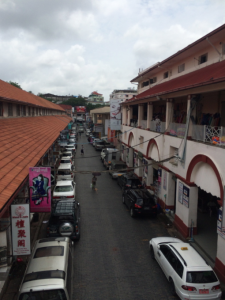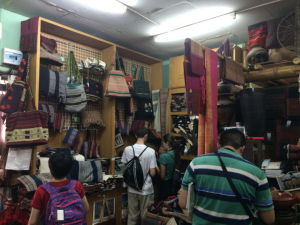Yo Ya May in Yangon, Myanmar
Yo Ya May, a small textile shop in Yangon, Myanmar, illustrates the unique occurrence of globalization in a local context. As I walked through the streets of Yangon in the summer of 2015, I immediately noticed the process of urbanization at work. Small markets and street-side vendors primarily dominated the urban landscape; however, signs of globalization were clearly increasing with the construction of seemingly big-box stores and globally influenced brands. The city streets bustled with cars, motorists, buses, and foot traffic. Both curious tourists and active local residents shared the public space and contributed to the complex dynamics taking place in this rapidly developing city.
I discovered Yo Ya May while traveling with a classmate from the local area. This classmate led a small group of people interested in gaining insight on the local shopping scene in Yangon to this covert storefront on the second floor of a traditional shopping mall. As Figure 1 and Figure 2 intend to illustrate, the urban landscape of Yangon includes pockets of new development mixed into the traditional and existing urban fabric. Figure 1 depicts the older marketplace where Yo Ya May does business. Figure 2 showcases the view from Yo Ya May’s façade and ultimately the construction of big-box stores. The juxtaposition between these two consumer destinations indicates the physical complexity of globalization and rapid urbanization.
The interior of Yo Ya May seemingly serves as a representation of a traditional small-scale Burmese vendor. The walls and floors were stacked with handcrafted textiles. The space was cramped, yet expansive. The unique, and incredibly beautiful, products were hardly marked with prices, which encouraged an interaction with the shopkeeper. In addition, photos and postcards on display encouraged shoppers to engage in the local context by learning about the history of the store and the artists involved.
While our group perused the artifacts for sale, a classmate engaged in conversation with the shopkeeper working that day—the son of the shop owning family. It was soon brought to our attention that this boy was similarly a college student who studied at Carleton College in Minnesota. Not only were we shocked by this realization, but also by the fact that his freshman roommate was the neighbor of a student on our trip. This epiphany indicated to us all that small-world connections occur on such a global scale.




